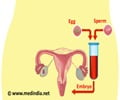US scientists have replaced genetic material in monkeys using a method that could prevent dozens of incurable hereditary diseases from being passed from mother to child, said a new study on Wednesday.
US scientists have replaced genetic material in monkeys using a method that could prevent dozens of incurable hereditary diseases from being passed from mother to child, said a new study on Wednesday.
"We think this technique could be applied very quickly in humans, and that it will work," said Shoukhrat Mitalipov, who led a team of researchers at the Oregon National Primate Research Center."Many of the procedures we developed could be simply mirrored to existing clinical in-vitro fertilisation (IVF) procedures used in humans," he told journalists by phone.
In experiments on rhesus monkey, hereditary material was removed from an egg containing defective mitochondrial DNA, or mtDNA, and inserted into a healthy donor egg stripped of its own heriditary package, called a spindle.
The modified eggs were then fertilised with sperm, implanted in females and carried to term.
"So far we have produced four infants by this method" -- named Mito, Tracker, Spindler and Spindy -- "and they are all healthy," said lead author Masahito Tachibana.
In humans, the new procedure would allow a couple to have a child who is biologically their own, but who is free of any condition associated maternal mtDNA.
Advertisement
Unlike DNA, which is a merger of male and female chromosomes, mitochondria are transmitted exclusively from mother to child.
Advertisement
Earlier studies have estimated one newborn in 200 carry mtDNA mutations which -- even if they do not cause disease in that individual -- can become more concentrated over generations.
One in 3,500-to-6,000 people are thought to have mutations in the mtDNA that may or will cause disease.
Some are rare and crippling degenerative disorders uniquely caused by mutations in mtDNA.
MERRF, for example, begins in childhood and leads to epilepsy, muscle wasting, deafness and dementia.
Another condition, known by the acronym LHON, causes blindness, impaired coordination, mild dementia and heart defects.
But mtDNA have also been linked to cancer and diabetes, along with neurodegenerative disorders such as Parkinson's, Alzheimer's and Huntington's.
Whether mutation in mtDNA can cause any of these diseases by itself, or whether it always acts in concert with other genetic or environmental factors, is still unclear.
In either case, though, the technique could pave the way for gene replacement therapy that simply removes disease-causing mitochondria from a family's hereditary chain.
"This type of therapy actually involves replacing genes in germline, which will be translated to the next generation," said Mitalipov.
So-called "germline gene therapy" has long been a holy grail of medicine, but making it work has proven far more difficult than once anticipated.
At this point, the barriers to clinical trials on humans are more legal and financial than scientific, the authors said.
Human gene replacement therapy is banned in many countries, including the United States and Britain, due to safety and ethical concerns.
"So far, this procedure looks really efficient and safe," said Mitalipov. "We believe that the data we have now are sufficient for FDA (US Food and Drug Administration) approval."
Because clinical gene therapy clinical trials -- if approved -- cannot be federally funded in the United States, Mitalipov said he is seeking private money to set up a new laboratory.
Source-AFP
LIN










